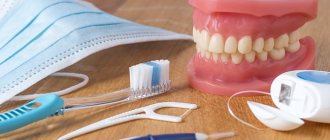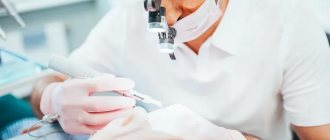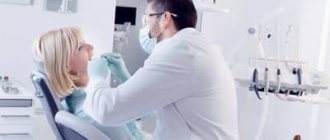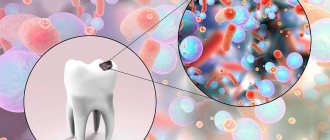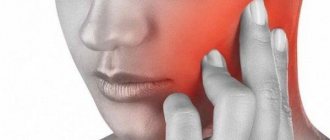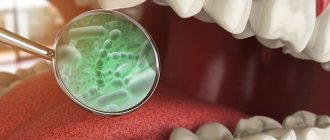Even with regular brushing and flossing, bacterial plaque will build up in your mouth over time. Bacterial activity leads to caries and periodontal disease. Therefore, it is important to visit a dental clinic for oral hygiene. Thanks to modern technologies, tartar and plaque are eliminated painlessly after the first cleaning. The price of oral hygiene may seem high, but the result is surprising, because even after this procedure, teeth look 2-3 shades whiter.
Indications for oral hygiene
Plaque in hard-to-reach places mineralizes over time, increases in volume, grows along the crown and penetrates into the space under the gums. This leads to inflammation of the teeth and gums, tooth mobility and even tooth loss. Affordable professional oral hygiene helps prevent the following consequences:
- inflammatory processes in the gums, leading to periodontal disease and gingivitis;
- development of caries in hard-to-reach places;
- darkening and yellowing of tooth enamel.
We offer the best prices in Moscow for professional oral hygiene. Our clinic uses safe materials and modern equipment, which ensures painless and effective treatment.
A visit to a dental hygienist to remove soft and mineralized deposits is mandatory for those who are unable to fully clean the enamel on their own, for example:
- with dental implants to prevent their rejection;
- after the restoration procedure and installation of prostheses;
- with installed braces.
Experts recommend professional cleaning twice a year. This preventative measure will avoid costly treatment in the future.
Activities
For treatment, general and local treatment regimens are used, using immunocorrectors, prostaglandin inhibitors, non-steroidal anti-inflammatory drugs
, antioxidants.
Methods of physiotherapy and photodynamic effects
.
For local treatment, modern developments from both domestic and foreign manufacturers are used. All patients undergo oral sanitation and specific orthopedic treatment according to indications.
The department uses modern methods of diagnosis and treatment of the following diseases of the oral mucosa:
DYSBACTERIOSIS OF THE ORAL MUCOSA
To diagnose the disease, microbiological analysis of the oral cavity is used, the introduction and use of the PCR diagnostic method from lesions to study the microbiological status and identify various viruses.
RECURRENT APHTHOSIC STOMATITIS
For diagnosis, a comprehensive immunological examination is used, including the study of cellular and humoral immunity, interferon status, circulating immune complexes, the compliment system and interleukin status, based on the results of which immunocorrective therapy is prescribed. Photodynamic therapy is also used for treatment.
HERPETIC LESIONS
To diagnose the disease, PCR diagnostics, an immunological blood test to determine antibodies to viruses, as well as interferon status to determine sensitivity to antiviral drugs are used. Treatment includes antiviral therapy with modern drugs, local treatment and photodynamic therapy.
TOXIC-ALLERGIC LESIONS (exudative erythema multiforme, toxic-allergic stomatitis)
For diagnosis, a study of the patient’s allergic status, a general blood test and determination of immunoglobulins and circulating immune complexes (CIC) in the blood are used.
Treatment includes desensitizing, detoxification, and anti-inflammatory therapy. CHEILITIS
To diagnose the disease, optical coherence tomography, determination of tissue microcirculation, and PCR diagnostics are used. Treatment includes vitamin therapy, sedative therapy, phonophoresis with various drugs, photodynamic therapy.
MELKERSSON-ROZENTHAL SYNDROME
For diagnosis, an immunological study is carried out, the determination of antibodies to viruses, and tissue microcirculation is determined. Treatment includes antiviral, immunomodulatory, and laser therapy.
LEUKOPLAKIA
For diagnosis, morphological research methods are used, including histological and immunohistochemical studies, and optical coherence tomography is also used to identify the disease in the early stages.
Treatment includes antiviral, anticandidal therapy, photodynamic therapy (PDT), laser ablation. Lichen planus
Complex and individualized treatment is used using modern means and methods, including immunomodulatory, antibacterial, antifungal, photodynamic therapy.
VESICOVASCULAR DISEASES (true pemphigus, vesicovascular syndrome, benign pemphigus)
For diagnosis, cytological examination of fingerprint smears is used to determine acantholytic cells, as well as histological examination.
ONCOLOGICAL DISEASES
For diagnosis, histological and immunohistochemical studies of the epithelium in biopsies from lesions of the oral mucosa are carried out.
Currently, more than 200 scientific articles have been published in various journals, monographs have been published, and a patent has been received for the invention of a method for treating herpetic stomatitis.
Back
Types of oral hygiene procedures
In Moscow, oral hygiene is performed by our specialists with higher education and many years of experience. The list of services provided in our medical center is presented in the table below.
| Procedure | Description | Advantages |
| Ultrasound removal of tartar | Removing large particles of mineralized plaque on enamel, cleaning the cervical area | Fast, painless. |
| Air Flow Cleaning | Removing soft pigmented plaque by spraying under pressure a fine mixture of water and structured soda. | Gentle and effective cleansing, lightening the enamel tone by 2-3 shades, eliminating unpleasant odors, preventing inflammatory diseases. |
| Polishing a dental crown after stone removal | Applying a special polishing paste to the crown | Elimination of roughness to prevent plaque re-formation |
| Strengthening enamel | Application of compounds with fluorine and calcium | Increasing the strength and resistance of enamel to an acidic environment. |
Prices for oral hygiene in our dentistry are distinguished by their democratic and affordable prices..
The complex of these procedures strengthens local immunity, reduces the number of bacteria, and minimizes the risk of developing dental and periodontal diseases.
Why is rehabilitation needed?
During this procedure, the doctor examines the oral cavity and diagnoses existing diseases, removes tartar, treats caries, and provides therapy for gum inflammation and other pathologies. At the end of the visit, the patient receives detailed recommendations on preventive measures to prevent problems with teeth and gums.
A certificate from the dentist about sanitization contains the phrase “the oral cavity has been sanitized.” What does it mean? This sentence indicates that all existing foci of the disease have been eliminated or were absent at the time of admission. If during an examination the dentist states that the oral cavity needs sanitation, the patient will receive a conclusion about the treatment completed only after all procedures have been completed.
To ensure that your teeth and gums always remain healthy, it is important to visit the dentist regularly (once every 6 months) and promptly stop any negative effects that begin. It is not recommended for people suffering from heart disease, asthma, diabetes, etc. to refuse to see a dentist.
Sanitation of the oral cavity before surgery is of great importance. A dental examination on the eve of surgery will prevent the possibility of infectious complications when harmful microorganisms enter the oral cavity.
Sanitation is divided into two categories depending on the specifics of the implementation. It can be centralized or decentralized. Centralized means that the patient comes for examination independently to a clinic or hospital. Decentralized is when an examination is carried out in an organized manner on a whole group of people at a school, workplace or other institution right in the office of a paramedic or doctor. The form of rehabilitation is:
- Individual. A person turns to a doctor of his own free will in order to identify incipient dental pathologies.
- One-time. It is carried out among a group of people according to a dispensary plan. For example, when collecting documents for school, applying for a job.
- Planned. It is systemic in nature and is aimed at maintaining a healthy oral cavity in people who need dispensary services. Similar inspections are carried out on a regular basis in schools, kindergartens, higher educational institutions, and factories.
Sign up for oral hygiene in Moscow
We are constantly working to make dental services affordable for everyone. Therefore, we offer to use installments for 12 months without prepayment or overpayment for all types of hygiene procedures.
Advantages of treatment in our clinic:
- use of high-tech German equipment and cutting-edge materials;
- safety and painlessness of treatment;
- polite and attentive staff;
- a wide range of dental services at reasonable prices;
- convenient location.
You can make an appointment with our specialists online on the website or by using the contact phone number.
Dental implantation
If a patient is missing a tooth (both frontal and chewing), this brings a lot of inconvenience, spoils the smile and, worst of all, leads to even more severe consequences for the entire dental-facial system. The absence of one or more teeth in the front part causes psychological discomfort; a person cannot smile fully and is forced to cover his mouth to hide the defect. In addition, the absence of a front or chewing tooth in a row provokes changes in facial features.
If the patient has lost a tooth, the load is redistributed to neighboring units: the teeth begin to shift, as a result of which their closure (bite) is disrupted. After displacement, the space between the teeth increases, where food debris begins to linger. This contributes to the rapid development of caries.
It is extremely important to install an implant in a timely manner, since if a lot of time has passed after the loss of a tooth, a loss (or thinning) of bone tissue occurs and successful implantation becomes impossible without prior osteoplastic surgery.
The clinic of advanced comprehensive dentistry CrocoDent offers a full range of services, from examination to dental implantation. We are responsible for the impeccable quality of our implants and guarantee that they will last for many years. Our dentists regularly improve their skills abroad, and in their work they use only the most innovative, advanced technologies and drugs.
Types of dental implants There are various dental implants and they differ in the type of thread, size, type of fastening and type of surface. The strongest implants with a wide base and a porous surface structure are installed in place of lost chewing teeth. It is these implants that can withstand significant loads.
At the appointment, the dentist selects implants individually for each patient, taking into account the thickness and density of the jaw bone. This is extremely important, since if the implant is not selected correctly, it may be rejected. In the upper dentition, the implant takes root on average in six months, in the lower dentition – in 4 months.
Implant installation - stages
Implantation is one of the most complex dental operations, and therefore requires a careful approach from both the doctor and the patient.
- Diagnostics
. To determine the condition of the dentofacial system, not only a visual examination is necessary, but also a computed tomography scan. This is necessary to assess the condition and volume of bone tissue and see possible pathologies. - Laboratory research
. The doctor will also ask you to conduct a series of laboratory tests - a general blood test, a coagulogram (blood clotting test), a biochemical blood test, and a test for HIV and hepatitis. - Sanitation of the oral cavity
. Before installing an implant, it is necessary to carry out professional oral hygiene and treat carious cavities. - Surgical stage
. After administering the anesthetic, the surgeon makes an incision in the gum in the area where the future implant will be installed, exposing a section of bone. A bed of artificial roots will form here. Using special cutters, the canal (bed) is prepared for the future implant. First, using a thin drill, the length of the canal is formed, and only then the doctor works on the required width. The implant is screwed into a hole in the bone and closed with a special plug. The incision site on the gum is sutured.
Single-stage implantation
In some cases, it is possible to carry out single-stage implantation - that is, simultaneous tooth extraction and implant installation. But the decision on the possibility of immediate implantation can only be made by a doctor based on the diagnostics performed, the condition of the bone tissue and gums.
In the process of one-stage implantation, the formation of a bed for the implant is not required. The tooth to be removed is removed as carefully as possible so as not to injure the bone tissue. The resulting cavity is sanitized. The doctor assesses the need for additional injection of bone tissue into the socket. Next, a dental implant is screwed into the socket and then the edges of the gum are sutured. In some cases, a gum former is fixed to the implant - with its help, the gum takes the shape necessary for the subsequent installation of a crown.
What implants do we work with?
At the CrocoDent clinic, only high-quality implants are used for dental implantation, which have proven themselves in world practice. These include:
- Nobel Biocare (Switzerland/USA)
- "Astra tech" (Sweden/Germany)
- "DENTIUM" (South Korea)
Risk of implant rejection
Successful implantation of an implant depends on several factors - the material from which the implant is made and the professionalism of the doctor. If the installation protocol and high-quality material are followed, the risk of implant rejection is minimal. According to statistics, implant rejection occurs only in 3-5% of cases.
Also, in order to reduce the risk of implant rejection, the patient is diagnosed before the operation - they find out what contraindications exist and what problems can be eliminated and the installation can be successfully carried out.
In modern dentistry, titanium implants are used. This metal is compatible with human tissue, is rarely rejected by the body and does not cause allergic reactions. Previously, for the manufacture of structures, alloys based on chromium, cobalt and steel were used, which are poorly compatible with the human body, so the percentage of rejections was many times higher.
Contraindications for implant installation
Like any other operation, implantation is not allowed for everyone. It will not be possible to install a titanium pin in patients who:
- diabetes mellitus (possibly if the course of the disease is stable and the blood sugar level is not high);
- tuberculosis
- HIV
- mental illnesses characterized by inappropriate behavior;
- oncological diseases;
- bleeding disorders and other blood diseases;
- recent heart attack or stroke.
Recommendations after implantation
- You should refrain from eating for 2 hours after the end of the operation (the effect of the anesthetics continues and there is a risk of injury to the operated area and soft tissues of the oral cavity).
- It is necessary to apply cold compresses (ice wrapped in a towel or napkin). Compresses should be applied during the first 3 hours of the postoperative period. Keep it cold for 20 minutes, then remove it for 20 minutes.
- Do not wash, clean or check the wound.
- For 7-10 days you should not eat solid foods or hot dishes. The diet should be gentle - soft, warm food.
- Brush your teeth gently twice a day.
- At the end of cleaning and after eating, it is necessary to make oral baths with an antiseptic solution (you cannot rinse!).
- For 3-4 days, avoid visiting baths, saunas, solariums and physical activity, such as sports. Avoid hypothermia.
- Do not drink alcohol, which is especially important when taking medications prescribed by your doctor. No medications not prescribed by a doctor!
- The postoperative period ends after the sutures are removed.
Sanitation of the oral cavity in children and pregnancy
In childhood, the procedure for sanitation of the oral cavity is carried out by a pediatric dentist. A certificate of rehabilitation is required before enrollment in schools and kindergartens, or trips to a health camp. The sanitation procedure involves removing plaque and tartar from teeth, treating caries and other dental diseases. For complete effective sanitation, it may be necessary to remove loose and untreatable primary teeth.
During pregnancy, sanitation of the oral cavity should be carried out with caution, and only after consultation with a specialist who monitors the course of pregnancy. If the expectant mother needs dental extraction or treatment, it is recommended to begin these procedures in the second trimester of pregnancy.
Usually, oral sanitation is carried out at the stage of preparation for conceiving a child. A timely visit to the dentist will allow you not to worry about your dental health throughout your pregnancy.
Hygienic teeth cleaning: price.
A service such as professional oral hygiene, the price of which is quite affordable at LeaderStom dentistry, is based on a set of dental procedures necessary to restore the oral microflora and prevent major dental diseases.
A consultation with our specialists will help you specify the cost of the service in your specific case.
Oral hygiene (Moscow) is carried out at a cost in different ranges. The main factor in determining the price for this service in the capital’s dentists depends on the type of teeth cleaning method, as well as the quality of the materials used.
Examples of work “Before” and “After”
Combination of removable and fixed prosthetics
Case: Partial absence of chewing teeth in the upper and lower jaws, the need for prosthetics of the anterior teeth of the upper jaw.
Combined prosthetics and dental implantation (June 2012)
Case: a large number of teeth are destroyed, partial adentia, chewing function is impaired due to the absence of almost all chewing teeth Work: a detailed diagnosis of the condition of the teeth and bone tissue, studies of the tension of the masticatory muscles, the position of the articular head in the temporomandibular joint were carried out.
Classical implantation and dental prosthetics (October 2012)
Case: need for implantation of a primary canine.
Restoration of anterior teeth with zirconium dioxide crowns
Case: destruction of the crown part of the front teeth.
